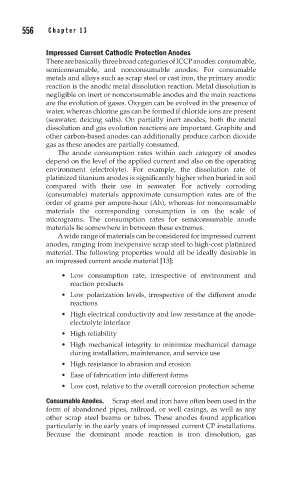Page 593 - Corrosion Engineering Principles and Practice
P. 593
556 C h a p t e r 1 3 C a t h o d i c P r o t e c t i o n 557
Impressed Current Cathodic Protection Anodes
There are basically three broad categories of ICCP anodes: consumable,
semiconsumable, and nonconsumable anodes. For consumable
metals and alloys such as scrap steel or cast iron, the primary anodic
reaction is the anodic metal dissolution reaction. Metal dissolution is
negligible on inert or nonconsumable anodes and the main reactions
are the evolution of gases. Oxygen can be evolved in the presence of
water, whereas chlorine gas can be formed if chloride ions are present
(seawater, deicing salts). On partially inert anodes, both the metal
dissolution and gas evolution reactions are important. Graphite and
other carbon-based anodes can additionally produce carbon dioxide
gas as these anodes are partially consumed.
The anode consumption rates within each category of anodes
depend on the level of the applied current and also on the operating
environment (electrolyte). For example, the dissolution rate of
platinized titanium anodes is significantly higher when buried in soil
compared with their use in seawater. For actively corroding
(consumable) materials approximate consumption rates are of the
order of grams per ampere-hour (Ah), whereas for nonconsumable
materials the corresponding consumption is on the scale of
micrograms. The consumption rates for semiconsumable anode
materials lie somewhere in between these extremes.
A wide range of materials can be considered for impressed current
anodes, ranging from inexpensive scrap steel to high-cost platinized
material. The following properties would all be ideally desirable in
an impressed current anode material [13]:
• Low consumption rate, irrespective of environment and
reaction products
• Low polarization levels, irrespective of the different anode
reactions
• High electrical conductivity and low resistance at the anode-
electrolyte interface
• High reliability
• High mechanical integrity to minimize mechanical damage
during installation, maintenance, and service use
• High resistance to abrasion and erosion
• Ease of fabrication into different forms
• Low cost, relative to the overall corrosion protection scheme
Consumable Anodes. Scrap steel and iron have often been used in the
form of abandoned pipes, railroad, or well casings, as well as any
other scrap steel beams or tubes. These anodes found application
particularly in the early years of impressed current CP installations.
Because the dominant anode reaction is iron dissolution, gas

